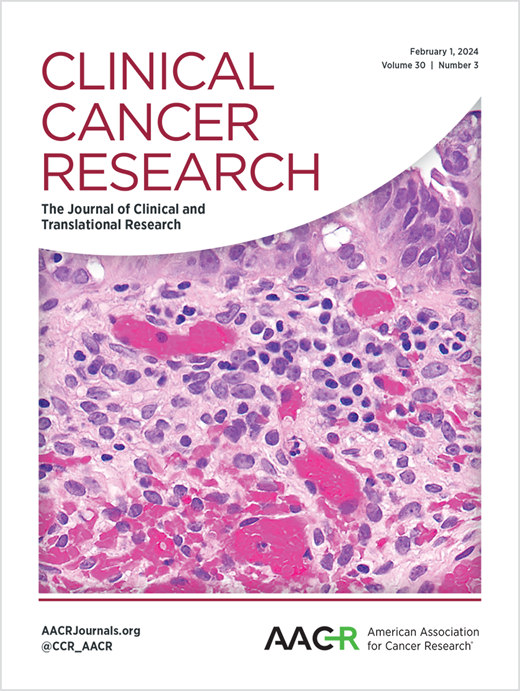用于预测甲状腺乳头状癌患者预后和治疗反应的人工智能驱动术前放射亚型
IF 10
1区 医学
Q1 ONCOLOGY
引用次数: 0
摘要
目的:8%-28%的甲状腺乳头状癌(PTC)会复发,这使得风险分层和治疗变得复杂。我们之前发现了一种与不良预后相关的PTC炎症分子亚型。基于这一亚型,我们旨在开发并验证一种非侵入性放射学特征,以预测PTC患者的预后和治疗反应。实验设计:我们收集了两个大型独立中心的术前超声图像(n=2506),以开发和验证用于预测PTC炎症亚型的深度学习炎症放射组学特征(DLRI),包括其与预后和抗炎中药(TCM)治疗的相关性。训练集 1(n=64)和内部验证集 2(n=1108)来自天津医科大学肿瘤医院。外部验证集 1(n=76)和验证集 2(n=1258)来自复旦大学上海肿瘤防治中心。结果我们开发的DLRI能准确预测PTC的炎症亚型(训练集1的AUC=0.97,外部验证集1的AUC=0.82)。在第一个队列(HR=16.49,95% CI:7.92-34.35,P<0.001)和第二个队列(HR=5.42,95%:3.67-8.02,P<0.001)中,高风险 DLRI 与无病生存率低显著相关。无论临床病理变量如何,DLRI都能独立预测无病生存期(P<0.001)。此外,高危DLRI患者可能从抗炎中药治疗中获益(HR=0.19,95% CI:0.06-0.55,P=0.002),而低危DLRI患者则没有获益。结论DLRI是评估PTC患者预后和指导抗炎中药治疗的可靠无创工具。需要进行前瞻性研究来证实这些发现。本文章由计算机程序翻译,如有差异,请以英文原文为准。
An AI-driven preoperative radiomic subtype for predicting the prognosis and treatment response of patients with papillary thyroid carcinoma
Purpose: 8-28% of Papillary thyroid carcinoma (PTC) experience recurrence, complicating risk stratification and treatment. We previously identified an inflammatory molecular subtype of PTC associated with poor prognosis. Based on this subtype, we aimed to develop and validate a noninvasive radiomic signature to predict prognosis and treatment response in PTC patients. Experimental Design: We collected preoperative ultrasound images from two large independent centers (n=2506) to develop and validate a Deep Learning Radiomics signature of Inflammation (DLRI) for predicting the inflammatory subtype of PTC, including its correlation with prognosis and anti-inflammatory traditional Chinese medicine (TCM) treatment. Training set 1 (n=64) and internal validation set 2 (n=1108) were from Tianjin Medical University Cancer Institute and Hospital. External validation set 1 (n=76) and 2 (n=1258) were from Fudan University Shanghai Cancer Center. Results: We developed DLRI to accurately predict PTC's inflammatory subtype (AUC=0.97 in the training set 1 and AUC=0.82 in the external validation set 1). High-risk DLRI was significantly associated with poor disease-free survival in the first cohort (HR=16.49, 95% CI: 7.92-34.35, P<0.001) and second cohort (HR=5.42, 95%: 3.67-8.02, P<0.001). DLRI independently predicted disease-free survival, irrespective of clinicopathological variables (P<0.001 for all). Furthermore, patients with high-risk DLRI were likely to benefit from anti-inflammatory TCM treatment (HR=0.19, 95% CI: 0.06-0.55, P=0.002), whereas those in low-risk DLRI did not. Conclusions: DLRI is a reliable noninvasive tool for evaluating prognosis and guiding anti-inflammatory TCM treatment in PTC patients. Prospective studies are needed to confirm these findings.
求助全文
通过发布文献求助,成功后即可免费获取论文全文。
去求助
来源期刊

Clinical Cancer Research
医学-肿瘤学
CiteScore
20.10
自引率
1.70%
发文量
1207
审稿时长
2.1 months
期刊介绍:
Clinical Cancer Research is a journal focusing on groundbreaking research in cancer, specifically in the areas where the laboratory and the clinic intersect. Our primary interest lies in clinical trials that investigate novel treatments, accompanied by research on pharmacology, molecular alterations, and biomarkers that can predict response or resistance to these treatments. Furthermore, we prioritize laboratory and animal studies that explore new drugs and targeted agents with the potential to advance to clinical trials. We also encourage research on targetable mechanisms of cancer development, progression, and metastasis.
 求助内容:
求助内容: 应助结果提醒方式:
应助结果提醒方式:


